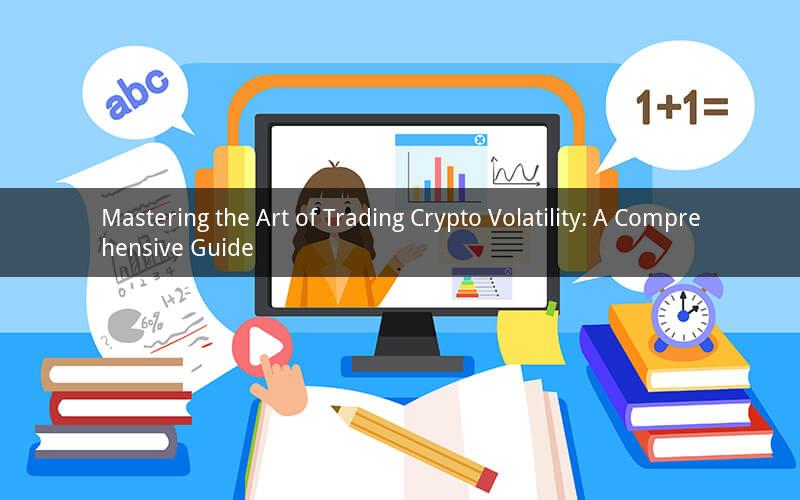
Introduction:
The cryptocurrency market is known for its extreme volatility, making it both a challenging and exciting place for traders. Understanding how to trade crypto volatility is crucial for anyone looking to capitalize on the market's fluctuations. This guide will provide you with essential strategies and tips to help you navigate the world of crypto volatility trading.
1. Understanding Crypto Volatility:
Crypto volatility refers to the rapid and significant price movements in the cryptocurrency market. These fluctuations can be caused by various factors, including regulatory news, technological advancements, market sentiment, and macroeconomic events. To trade crypto volatility effectively, you must first understand its causes and effects.
2. Choosing the Right Cryptocurrency:
Not all cryptocurrencies exhibit the same level of volatility. Before diving into the market, research and identify cryptocurrencies with high volatility. Bitcoin, Ethereum, and Ripple are popular choices for traders looking to capitalize on volatility.
3. Risk Management:
Effective risk management is crucial when trading crypto volatility. Here are some key strategies to help you mitigate risks:
a. Set stop-loss orders: A stop-loss order is an instruction to sell a cryptocurrency when its price reaches a certain level. This helps protect your investment from significant losses.
b. Diversify your portfolio: Don't put all your capital into a single cryptocurrency. Diversifying your portfolio can help reduce the impact of volatility on your overall investment.
c. Use leverage cautiously: Leverage can amplify gains, but it can also magnify losses. Only use leverage if you have a thorough understanding of its risks and are prepared to handle potential losses.
4. Technical Analysis:
Technical analysis involves studying historical price and volume data to predict future price movements. Here are some essential technical analysis tools and indicators for trading crypto volatility:
a. Bollinger Bands: This indicator helps identify overbought and oversold levels in the market. Traders often look for price breaks above the upper Bollinger Band as a sign of increased volatility.
b. Moving Averages: Moving averages can help identify trends and potential reversal points. Traders often use different time frames to determine the overall market sentiment.
c. RSI (Relative Strength Index): The RSI measures the magnitude of recent price changes to identify overbought and oversold conditions. A RSI reading above 70 indicates overbought, while a reading below 30 indicates oversold.
5. Sentiment Analysis:
Market sentiment plays a significant role in crypto volatility. By analyzing sentiment, you can gain insights into the market's potential direction. Here are some tips for conducting sentiment analysis:
a. Social media: Keep an eye on social media platforms like Twitter and Reddit to gauge market sentiment.
b. News and media: Stay updated with the latest news and media reports to understand potential market-moving events.
c. Sentiment indicators: Use sentiment indicators like the Crypto Fear & Greed Index to get a sense of the overall market sentiment.
6. Trading Strategies:
There are several trading strategies you can use to capitalize on crypto volatility:
a. Scalping: Scalping involves buying and selling cryptocurrencies within a short time frame to profit from small price movements. This strategy requires quick decision-making and a high level of market awareness.
b. Swing trading: Swing trading involves holding positions for several days or weeks to capitalize on larger price movements. This strategy requires patience and a good understanding of market trends.
c. Day trading: Day trading involves buying and selling cryptocurrencies within a single trading day. This strategy requires a strong understanding of market dynamics and the ability to react quickly to market changes.
7. Monitoring and Adjusting Your Strategy:
The cryptocurrency market is constantly evolving, so it's crucial to monitor your trading strategy and make adjustments as needed. Here are some tips for monitoring and adjusting your strategy:
a. Keep a trading journal: Document your trades, strategies, and performance to identify areas for improvement.
b. Stay informed: Stay updated with the latest market news and developments to ensure your strategy remains relevant.
c. Be flexible: Be willing to adapt your strategy based on market conditions and your own performance.
Conclusion:
Trading crypto volatility requires a solid understanding of the market, effective risk management, and a well-defined trading strategy. By following the tips and strategies outlined in this guide, you can improve your chances of success in the crypto market. Remember, trading crypto volatility involves significant risks, so always do your research and never invest more than you can afford to lose.
Questions and Answers:
1. Q: What is the difference between scalping and day trading?
A: Scalping involves buying and selling cryptocurrencies within a few minutes to seconds, while day trading involves holding positions for several hours to a day.
2. Q: How can I stay updated with the latest market news and developments?
A: Follow reputable cryptocurrency news websites, social media platforms, and join online forums to stay informed about the latest market trends and news.
3. Q: Is it better to trade Bitcoin or Ethereum when looking to capitalize on crypto volatility?
A: Both Bitcoin and Ethereum can be volatile, but their price movements may differ. Research and analyze each cryptocurrency's volatility to determine which one suits your trading strategy.
4. Q: What is the best way to manage risk when trading crypto volatility?
A: Set stop-loss orders, diversify your portfolio, and use leverage cautiously. It's also essential to understand your risk tolerance and never invest more than you can afford to lose.
5. Q: How can I improve my trading strategy over time?
A: Keep a trading journal to analyze your performance, stay updated with market news and developments, and be flexible in adjusting your strategy as needed.